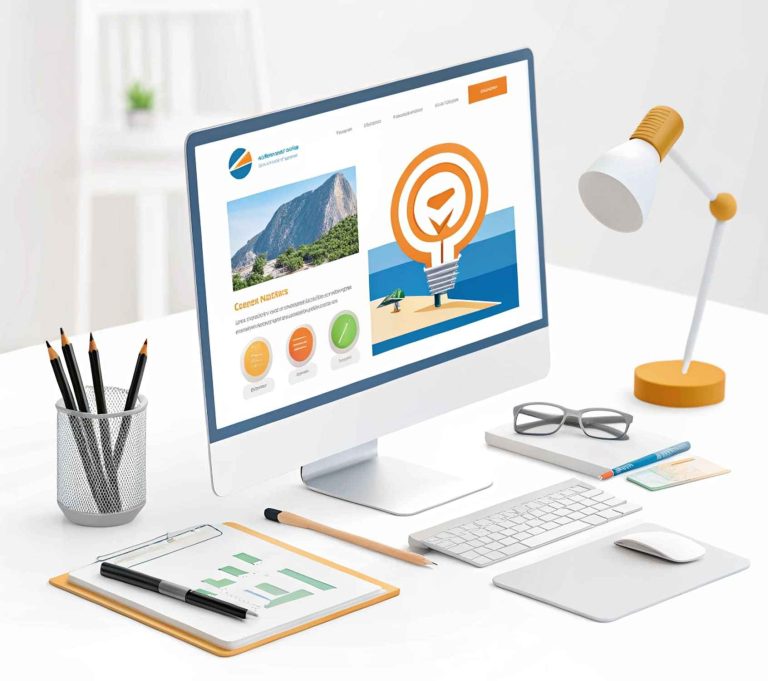
The success of a website directly depends on the quality of its web design, as it forms the first impression and influences further user actions. The main task at the development stage is to keep the visitor’s attention so that they don’t close the page in the first seconds. In addition to visual appeal, the resource should be user-friendly and functional: an intuitive interface and fast loading leave a positive impression.
Important principles of effective web design development
To make a website user-friendly and attractive, it is important to follow a few basic principles that will help make it accessible and enjoyable to use:
1. Simplicity. An excessive amount of graphic elements and text only confuses visitors. Minimalism in design allows users to quickly find the information they need. This can increase the percentage of repeat visits.
2. Usability. Intuitive navigation and a logical structure make it easy and fast to navigate between sections. Sometimes owners want to improve their resource, but this can only confuse the user, which will create a negative impression.
3. Loading speed. Image optimization, minimizing the use of scripts, and high-quality hosting will help make the site fast. This is a very important indicator, as delays increase the number of bounces in the first seconds.
4. Adaptability. The site should be displayed correctly on both computers and mobile devices. An adaptive version is a must, as the number of visitors from portable devices is increasing every year.
Adherence to these principles will make the resource comfortable for users, increasing their trust and retention on the page.
Visual elements that attract users
The appearance of the main page and categories forms the first impression. Attractiveness directly affects the way users interact with the content. The design should be clear and evoke positive emotions.
- Harmonious color palette. Using the right colors helps to create a pleasant atmosphere and inspires confidence in the website.
- Typography. Easy-to-read fonts and optimal text sizes make it easy to perceive information.
- Images and graphics. The use of high-quality and thematic images helps to make a website more attractive and understandable.
A well-thought-out combination of colors, fonts, and graphic elements helps to make a website pleasant to look at and provides a positive user experience.
How to make a website user-friendly and efficient
In addition to good design, a website should be logically structured and easy to use. UX/UI design allows you to create a comfortable user experience and keep them on the site longer.
- Logical page structure. It is important to place key elements in clear positions where users expect to find them. As a rule, the main categories are placed at the top or on the sides of the main content.
- CTA buttons. Call-to-action buttons should be noticeable, contrasting, and contain a clear call to action (“Order”, “Learn more”, “Buy now”). You can also place a window with an online consultant or contact manager.
- Animations and micro-interactions. Light animation effects can improve user interaction by making the site more dynamic. The main thing is not to overload the page too much so that the user performs the desired action: subscribe, buy, click, etc.
A well-thought-out UX/UI makes a website pleasant and convenient for users, which ultimately increases the number of requests and conversion.
User psychology in web design
Effective web design takes into account the behavioral characteristics of users. Some design techniques help to influence the emotions of visitors and direct them to certain actions. Professional designers take into account a number of key points when developing a website:
- using the right colors creates a certain mood: blue inspires trust, red encourages action, green is associated with safety;
- the shape and arrangement of elements affect how the user perceives the site and where they direct their attention;
- additional triggers, such as countdown timers or social evidence (reviews, ratings), encourage decision-making.
Understanding the psychology of users helps to improve interaction with the site and increase its effectiveness. As a result, you can get a resource that is attractive, useful, and easy to use.
Mistakes in web design that repel visitors
Even an attractive website can repel visitors due to mistakes. Some flaws reduce trust and lead to a high bounce rate.
- oversaturation of elements – an excess of banners, text, bright details, and advertising windows creates visual chaos and repels users;
- poor contrast – dark text on a dark background or too bright colors make it difficult to read;
- excessive use of pop-ups – when a user is faced with several tabs in a row, it causes irritation.
Avoiding these mistakes will help make your website more convenient and pleasant for visitors. Creating an effective web design is a combination of aesthetics, convenience, and understanding of user behavior. It is important to consider simplicity, content quality, speed, and intuitiveness of the interface. By following these recommendations, you can make your website not only attractive but also as effective as possible for your business, increasing its conversion and user retention.


